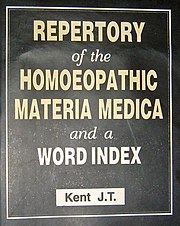Preparation of Remedies - Contd. - Part 3
Dilution calculation
α. ^ Calculation of numbers of molecules in dilutions
Also
- Number of molecules in initial solution = number of moles x Avogadro's constant
Therefore, for 1 L of a 1 M solution
- Moles = 1 × 1 = 1 mole
- Molecules = 1 × 6.02×1023 = 6.02×1023 molecules
The 10-fold dilution required to reduce the number of molecules to less than one per litre is 1 part in 1×1024 (24X or 12C) since:
- 6.02×1023/1×1024 = 0.6 molecules per litre
Coverage in the mainstream press
The BBC's Horizon and ABC's 20/20 broadcast programs described scientific testing of homeopathic dilutions that were unable to differentiate these dilutions from water.[70][90]
Provings
In order to determine which specific remedies could be used to treat which diseases, Hahnemann experimented on himself and others for several years, before using remedies on patients. His experiments did not initially consist of giving remedies to the sick, because he thought that the most similar remedy, by virtue of its ability to induce symptoms similar to the disease itself, would make it impossible to determine which symptoms came from the remedy and which from the disease itself. Therefore, sick people were excluded from these experiments. The method used for determining which remedies were suitable for specific diseases was called "proving", after the original German word "Prüfung", meaning "test".) A homeopathic proving is the method by which the profile of a homeopathic remedy is determined.[91]
During the process of proving, Hahnemann used healthy volunteers who were given remedies, often in molecular doses, although he later advocated proving with remedies at a 30C dilution,[73] and the resulting symptoms were compiled by observers into a "Drug Picture". During the process the volunteers were observed for months at a time and were made to keep extensive journals detailing all of their symptoms at specific times during the day. During the tests volunteers were forbidden from consuming coffee, tea, spices, or wine. They were also not allowed to play chess, because Hahnemann considered it to be "too exciting", though they were allowed to drink beer and were encouraged to moderately exercise. After the experiments were over, Hahnemann made the volunteers offer their hands and take an oath swearing that what they reported in their journals was the truth, at which time he would interrogate them extensively concerning their symptoms.
Provings have been described as important in the development of the clinical trial, due to their early use of simple control groups, systematic and quantitative procedures, and some of the first application of statistics in medicine.[92] The lengthy records of self-experimentation by homeopaths have occasionally proven useful in the development of modern drugs: For example, evidence nitroglycerin might be useful as a treatment for angina was discovered by looking through homeopathic provings, though homeopaths themselves never used it for that purpose at that time.[93] The first recorded provings were published by Hahnemann in his 1796 Essay on a New Principle. His Fragmenta de viribus (1805)[94] contained the results of 27 provings, and his 1810 Materia Medica Pura contained 65.[95] 217 remedies underwent provings for James Tyler Kent's 1905 Lectures on Homoeopathic Materia Medica, and newer substances are continually added to contemporary versions.
Repertory
A compilation of reports of many homeopathic provings is known as a homeopathic materia medica. In practice the usefulness of such a compilation is limited because a practitioner does not need to look up the symptoms for a particular remedy, but rather to explore the remedies for a particular symptom. This need is filled by the homeopathic repertory, which is an index of symptoms, listing after each symptom those remedies that are associated with it. Repertories are often very extensive and may include data from clinical experience in addition to provings. There is often lively debate among the compilers of a repertory and interested practitioners over the veracity of a particular inclusion. The first symptomatic index of the homeopathic materia medica was arranged by Hahnemann. Soon after, one of his students Clemens von Bönninghausen, created the Therapautic Pocket Book, another homeopathic repertory.[96] The first such Homeopathic Repertory was Dr. George Jahr's Repertory, published in 1835 in German and then again in 1838 in English and edited by Dr. Constantine Hering. This version was less focused on disease categories and would be the forerunner to Kent's later works.[97] It consisted of three large volumes. Such repertories increased in size and detail as time progressed.
Labels: concentration, Coverage in the mainstream press, Dilution, Homeopathy, molecules, moles, Provings



0 Comments:
Post a Comment
Subscribe to Post Comments [Atom]
<< Home